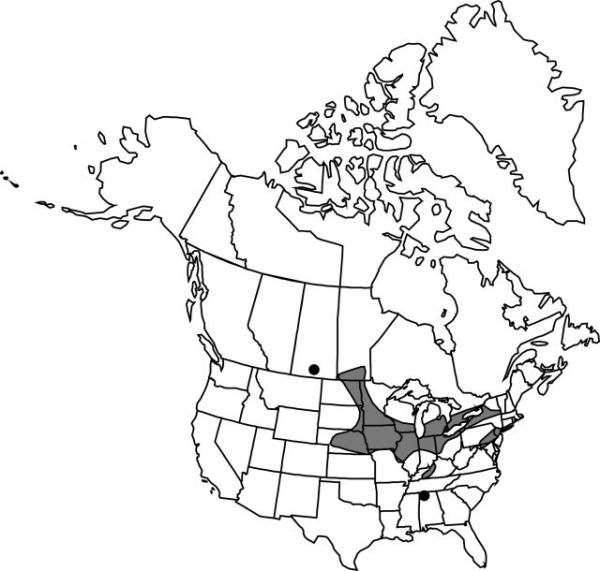Cypripedium candidum
Sp. Pl. 4(1): 142. 1805.
Plants erect, 11–40 cm. Leaves 3–4 (–5), on proximal or middle portion of stem, alternate, erect-ascending; blade lanceolate or elliptic to oblanceolate, 7–20 × 0.9–5.3 cm. Flowers 1 (–2); sepals green to pale brownish yellow, usually spotted and striped with reddish-brown or madder; dorsal sepal ovate to ovate-lance-acuminate, 15–35 × 7–13 mm; lateral sepals connate; synsepal 13–35 × 7–15 mm; petals spreading to somewhat deflexed, same color as sepals, spirally twisted or spiral-undulate, lanceolate to linearlanceolate, 23–46 × 3–5 mm; lip white, obovoid or oblance-ovoid to oblance-fusiform, 17–27 mm; orifice basal, 10–15 mm; staminode lanceoloid or oblong-lanceoloid to ellipsoid. 2n = 20.
Phenology: Flowering Apr–Jul.
Habitat: Mesic to wet prairies and fen meadows, very rarely open wooded slopes
Elevation: 70–700 m
Distribution

Man., Ont., Sask., Ala., Ill., Ind., Iowa., Ky., Md., Mich., Minn., Mo., Nebr., N.J., N.Y., N.Dak., Ohio, Pa., S.Dak., Wis.
Discussion
Cypripedium candidum begins blooming while the shoots are still emerging from the soil; at that time they are small, with the leaves clustered near the base. The plants enlarge greatly during and after anthesis, and the leaves may assume a more median position. The orifice of the lip in C. candidum is distinctive, the apical margin forming an acute angle. This feature is shared with C. montanum and differs from the commonly obtuse margin in C. parviflorum; hence, it can aid determination of discolored herbarium specimens. Hybrids of C. candidum and C. parviflorum have been designated C. ×andrewsii A. M. Fuller. See 11. C. parviflorum for a general discussion of hybridization and variation within and between related species.
Selected References
None.